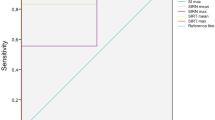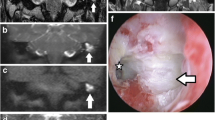Abstract
This paper summarizes the value of diffusion-weighted magnetic resonance imaging in the evaluation of temporal bone pathology. It highlights the use of different types of diffusion-weighted magnetic resonance imaging in the different types of cholesteatoma, prior to first stage surgery and prior to second look surgery. The value of diffusion-weighted magnetic resonance imaging in the evaluation of pathology of the apex of the petrous bone and the cerebellopontine angle is also discussed.



















Similar content being viewed by others
References
Thoeny HC, Keyzer D (2007) Extracranial applications of diffusion-weighted magnetic resonance imaging. Eur Radiol 17:1385–1393
Bammer R, Holdsworth SJ, Veldhuis WB, Skare ST (2009) New methods in diffusion-weighted and diffusion tensor imaging. Magn Reson Imaging Clin N Am 17:175–204
De Foer B, Vercruysse JP, Pilet B et al (2006) Single-shot, turbo spin-echo, diffusion-weighted imaging versus spin-echo planar, diffusion-weighted imaging in the detection of acquired middle ear cholesteatoma. ANJR Am J Neuroradiol 27:1480–1482
Dubrulle F, Souillard R, Chechin D et al (2006) Diffusion-weighted MR imaging sequence in the detection of postoperative recurrent cholesteatoma. Radiology 238:604–610
Lehmann P, Saliou G, Brochart C et al (2009) 3 T MR imaging of postoperative recurrent middle ear cholesteatomas: value of periodically rotated overlapping parallel lines with enhanced reconstruction diffusion-weighted MR imaging. AJNR Am J Neuroradiol 30:423–427
Nelson M, Roger G, Koltai PJ et al (2002) Congenital cholesteatoma: classification, management and outcome. Arch Otolaryngol Head Neck Surg 128:810–814
Kutz JW Jr, Friedman RA (2007) Congenital middle ear cholesteatoma. Ear Nose Throat J 86:654
Lemmerling M, De Foer B (2004) Imaging of cholesteatomatous and non-cholesteatomatouvarga, cholesteatomas middle ear disease. In: Lemmerling M, Kollias SS (eds) Radiology of the petrous bone. Springer, New York, pp 31–47
Barath K, Huber AM, Stämpfli P, Varga P, Kollias S (2010) Neuroradiology of cholesteatomas. AJNR Am J Neuroradiol Apr 1 (Epub ahead of print).
Brown JS (1982) A ten year statistical follow-up of 1142 consecutive cases of cholesteatoma: the closed versus the open technique. Laryngoscope 92:390–396
Schilder AG, Govaerts PJ, Somers T, Offeciers FE (1997) Tympano-ossicular allografts for cholesteatoma in children. Int J Pediatr Otorhinolaryngol 42:31–40
Mercke U (1987) The cholesteatomatous ear one year after surgery with obliteration technique. Am J Otol 8:534–536
Gantz BJ, Wilkinson EP, Hansen MR (2005) Canal wall reconstruction tympanomastoidectomy with mastoid obliteration. Laryngoscope 115:1734–1740
Offeciers E, Vercruysse JP, De Foer B, Casselman J, Somers T (2008) Mastoid and epitympanic obliteration. The obliteration technique. In: Ars B (ed) Chronic otitis media. Pathogenesis oriented therapeutic treatment. Kugler, Amsterdam, pp 299–327
Vercruysse JP, De Foer B, Somers T, Casselman JW, Offeciers E (2008) Mastoid and epitympanic bony obliteration in pediatric cholesteatoma. Otol Neurotol 29:953–960
Martin N, Sterkers O, Nahum (1990) Chronic inflammatory disease of the middle ear cavities: Gd-DTPA-enhanced MR imaging. Radiology 176:39–405
Fitzek C, Mewes T, Fitzek S et al (2002) Diffusion-weighted MRI of cholesteatomas of the petrous bone. J Magn Reson Imaging 15:636–641
Vercruysse JP, De Foer B, Pouillon M et al (2006) The value of diffusion-weighted MR imaging in the diagnosis of primary acquired and residual cholesteatoma: a surgical verified study of 100 patients. Eur Radiol 16:1461–1467
De Foer B, Vercruysse JP, Bernaerts A et al (2007) The value of single-shot turbo spin-echo diffusion-weighted MR imaging in the detection of middle ear cholesteatoma. Neuroradiology 49:841–848
7Lemmerling MM, De Foer B, VandeVyver V, Vercruysse JP, Kl V (2008) Imaging of the opacified middle ear. Eur J Radiol 66:363–371
Lemmerling MM, De Foer B, Verbist BM, VandeVyver V (2009) Imaging of inflammatory and infectious diseases in the temporal bone. Neuroimaging Clin N Am 19:321–337
De Foer B, Vercruysse JP, Bernaerts A et al (2010) Middle ear cholesteatoma: non-echo-planar diffusion-weighted MR imaging versus delayed gadolinium-enhanced T1-weighted MR—value in detection. Radiology 255:866–872
Venail F, Bonafe A, Poirrier V, Mondain M, Uziel A (2008) Comparison of echo-planar diffusion-weighted imaging and delayed postcontrast T1-weighted MR imaging for the detection of residual cholesteatoma. AJNR Am J Neuroradiol 29:1363–1368
Jeunen G, Desloovere C, Hermans R, Vandecavye V (2008) The value of magnetic resonance imaging in the diagnosis of residual or recurrent acquired cholesteatoma after canal wall-up tympanoplasty. Otol Neurotol 29:16–18
Sheehy JL, Brackman DE, Graham MD (1977) Cholesteatoma surgery: residual and recurrent disease. A review of 1024 cases. Ann Otol Rhinol Laryngol 86:451–462
Brackman DE (1993) Tympanoplasty with mastoidectomy: canal wall up procedures. Am J Otol 14:380–382
Vanden Abeele D, Coen E, Parizel PM, Van de Heyning P (1999) Can MRI replace a second look operation in cholesteatoma surgery? Acta Otolaryngol 119:555–561
Williams MT, Ayache D, Albert C et al (2003) Detection of postoperative residual cholesteatoma with delayed contrast-enhanced MR imaging: initial findings. Eur Radiol 13:169–174
Ayache D, Williams MT, Lejeune D, Corré A (2005) Usefulness of delayed postcontrast magnetic resonance imaging in the detection of residual cholesteatoma after canal wall-up tympanoplasty. Laryngoscope 115:607–610
Aikele P, Kittner T, Offergeld C et al (2003) Diffusion-weighted MR imaging of cholesteatoma tin pediatric and adult patients who have undergone middle ear surgery. AJR Am J Roentgenol 181:261–265
Stasolla A, Magliulo G, Parrotto D, Luppi G, Marini M (2004) Detection of postoperative relapsing/residual cholesteatoma with diffusion-weighted echo-planar magnetic resonance imaging. Otol Neurotol 25:879–884
De Foer B, Vercruysse JP, Bernaert A et al (2008) Detection of postoperative residual cholesteatoma with non-echo-planar diffusion-weighted magnetic resonance imaging. Otol Neurotol 29:513–517
Dhenpnorrarat RC, Wood B, Rajan GP (2009) Postoperative non-echo-planar diffusion-weighted magnetic resonance imaging changes after cholesteatoma surgery: implications for cholesteatoma screening. Otol Neurotol 30:54–58
Rajan GP, Ambett R, Wun L et al (2010) Preliminary outcomes of cholesteatoma screening in children using non-echo-planar diffusion-weighted magnetic resonance imaging. Int J Pediatr Otorhinolaryngol 74:297–301
De Foer B, Vercruysse JP, Pouillon M et al (2007) Value of high-resolution computed tomography and magnetic resonance imaging in the detection of residual cholesteatoma in primary bony obliterated mastoids. Am J Otolaryngol 28:230–234
Vercruysse JP, De Foer B, Somers T, Casselman J, Offeciers E (2010) Lont-term follow up after bony mastoid and epitympanic obliteration: radiological findings. J Laryngol Otol 124:37–43
Lemmerling M (2004) Petrous apex lesions. In: Lemmerling M, Kollias SS (eds) Radiology of the petrous bone. Springer, New York, pp 171–179
Schmalfuss IM (2009) Petrous apex. Neuroimaging Clin N Am 19:367–391
Silveira Filho LG, Ayache D, Sterkers O, Williams MT (2010) Middle ear cholesteatoma extending into the petrous apex. Otol Neurotol 31:544–545
Alkilic-Genauzeau I, Boukobza M, Lot G, George B, Merland JJ (2007) CT and MRI features of arachnoid cyst of the petrous apex: report of 3 cases. J Radiol 88:1179–1183
Bonneville SJ, Chiras J (2007) Imaging of cerebellopontine angle lesions: an update. Part 1: enhancing extra-axial lesions. Eur Radiol 17:2472–2482
Bonneville F, Savatovsky J, Chiras J (2007) Imaging of cerebellopontine angle lesions: an update. Part 2: intra-axial lesions, skull base lesions that may invade the CPA region, and non-enhancing extra-axial lesions. Eur Radiol 17:2908–2920
Liu P, Saida Y, Yoshioka H, Itai Y (2003) MR imaging of epidermoids at the cerebellopontine angle. Magn Reson Med Sci 2:109–115
Conflict of interest
We declare that we have no conflict of interest.
Author information
Authors and Affiliations
Corresponding author
Rights and permissions
About this article
Cite this article
De Foer, B., Vercruysse, JP., Spaepen, M. et al. Diffusion-weighted magnetic resonance imaging of the temporal bone. Neuroradiology 52, 785–807 (2010). https://doi.org/10.1007/s00234-010-0742-1
Received:
Accepted:
Published:
Issue Date:
DOI: https://doi.org/10.1007/s00234-010-0742-1




